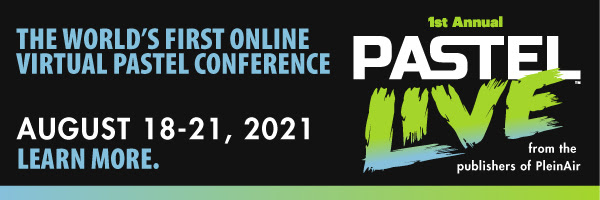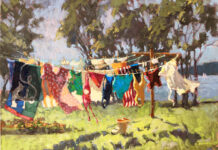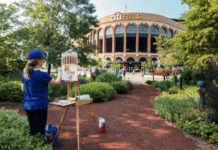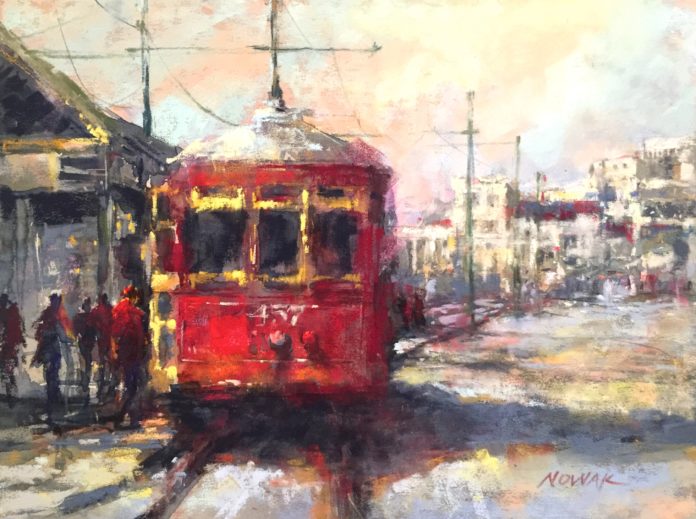
Painting en Plein Air > Striving to evoke an emotional response to the beauty in the everyday, Georgia-based painter Nancy Nowak imbues her representational pastels with an impressionist flair.
Making an Impression
BY ROBERT K. CARSTEN
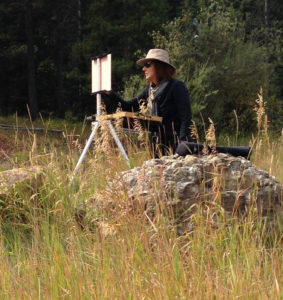
I much prefer to paint scenes that are mundane,” says Nancy Nowak. “As long a s a painting has a strong composition, color harmony, interesting arrangement of shapes, is skillfully painted, and evokes some kind of emotional connection, the subject matter can be anything.
The challenge for me is to see the beauty in a place that you would walk right past and deem as very ordinary and then elevate it in a painting to make it compelling for the viewer. I want to communicate that there is beauty all around us, to remind us to look up from our devices and truly see the beauty that we often take for granted.”
In “House by the Tracks,” for example, Nowak depicts a mundane, small-town Georgia scene where the railroad tracks run through — some-thing many would consider an eyesore — and turns it into an expressive gem of light effect and mood.
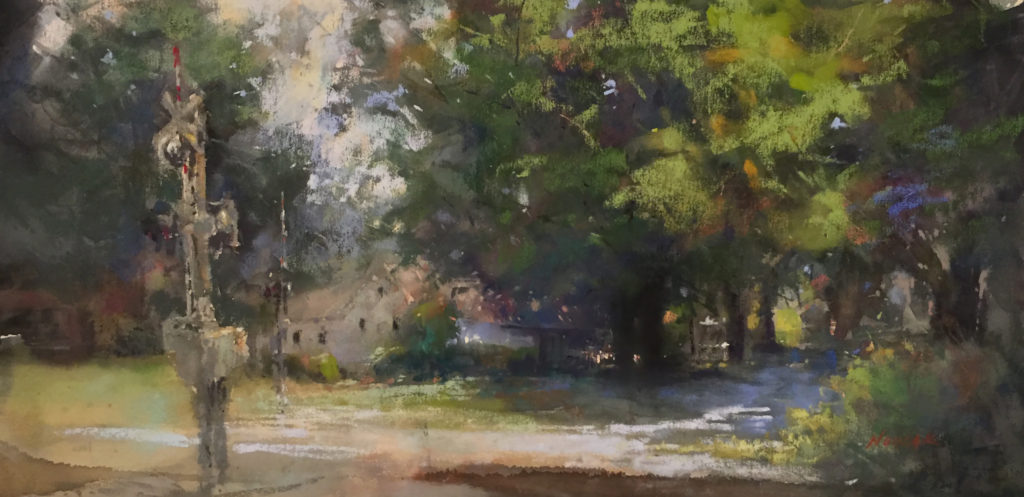
THE WOW FACTOR
In Nowak’s work, any tendency toward precise rendering of subject matter is generally sup-planted by interpretation, which is informed by her compelling, emotional response to the scene. “I am attracted to painterly paintings,” she says. “I don’t have the patience for realistic accuracy, which I find inhibiting. I don’t want to just duplicate the scene. Interpreting it in a painterly, expressive way adds that extra wow factor, and besides, I just want to enjoy painting.”
Like impressionist painters of the past, Nowak is exceedingly captivated and inspired by the ever-changing effects of light and atmosphere. She uses and accentuates qualities within these elements to tell a story of time and place. “Spring’s Arrival” was accomplished en plein air at a lake in her neighborhood. “I’ve painted there many times, but this was the first time I concentrated solely on the trees,” she says.
“The challenge was all of those greens — how was I going to make the trees plein air interesting and have the painting work without it becoming a ‘green’ painting?” She answered this challenge by carefully working color temperatures and values to produce interesting color harmonies and contrasts, creating a noteworthy, impressionistic sense of atmosphere and light.
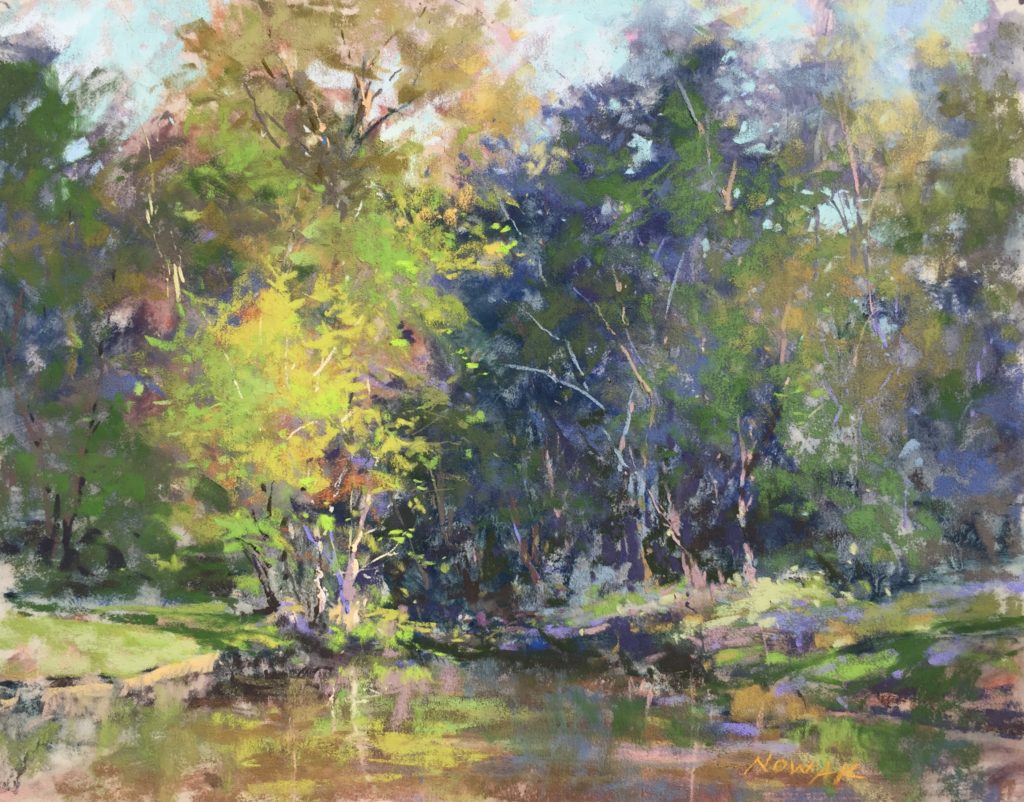
The artist first established an underpainting using hard pastels — NuPastels and Cretacolor — which contrasted with the local colors, including substituting oranges and violets for the green trees. Next, she solidified those forms by brushing over them with isopropyl alcohol. When the forms were dry, she enhanced and elaborated on the simple, flat shapes, bringing them more to life by using watercolor washes in tints and shades of various hues.
The final step was to add wisps and dashes of soft pastel, mostly Unison, Schmincke, and Terry Ludwig, to complete the painting. “Green is always my last layer, and I used it sparingly.” Nowak says. “I love all those colors underneath which make the painting more exciting. I did use considerably more pastel on the focal point of the small tree in order to establish contrast and a strong light effect.”
Shaping Up
One of the remarkable features in Nowak’s pastel paintings is the strong emphasis she places on shapes. Whether out in the landscape or painting in her studio from photos, she feels that initially identifying one dominant shape, and then finding ways of relating selected other shapes to it and around it, is paramount to designing strong compositions. “I’m a shape girl,” she wittily remarks, adding, “I’m really attracted to interesting shapes.”
In her plein air pastel “Farmer’s Market,” she employs the strong, dark shapes of the truck and its shadow to contrast with the lightest lights of the figure and umbrella directly above. This creates a focal area, acting as a counterpoint to the organic shape of the tree trunk, the signpost, and the bustling activity on the left side of the composition.
The artist brings a sense of unity to the painting by limiting her palette to orange-browns, blues, and greens. Also of note is her use of diagonals to activate and add depth to the composition, while placing a horizontal, linear form across the composition at the upper golden section, that of the umbrellas’ lower edges. This serves to stabilize the composition by creating opposition to the multiple verticals.
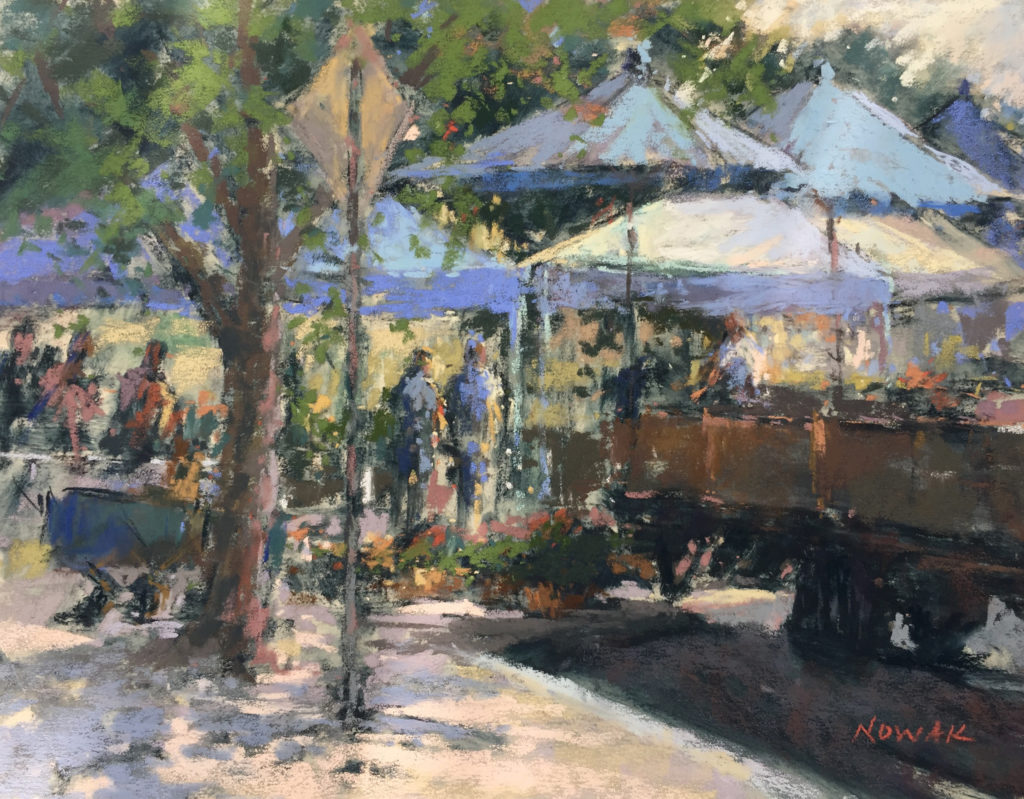
In “French Quarter Stroll,” the artist’s quick impression of the street scene is anchored by a limited palette and the massing of darks and lights. Both foreground figures combine to create a dark shape contrasted against surrounding light, which is capped by the dark horizontal of figures on the right and storefronts on the left, allowing the heads and shoulders of the foreground individuals to stand out. The geometric shapes of architecture on the right are close in value to one another, as are the lighter buildings on the left.
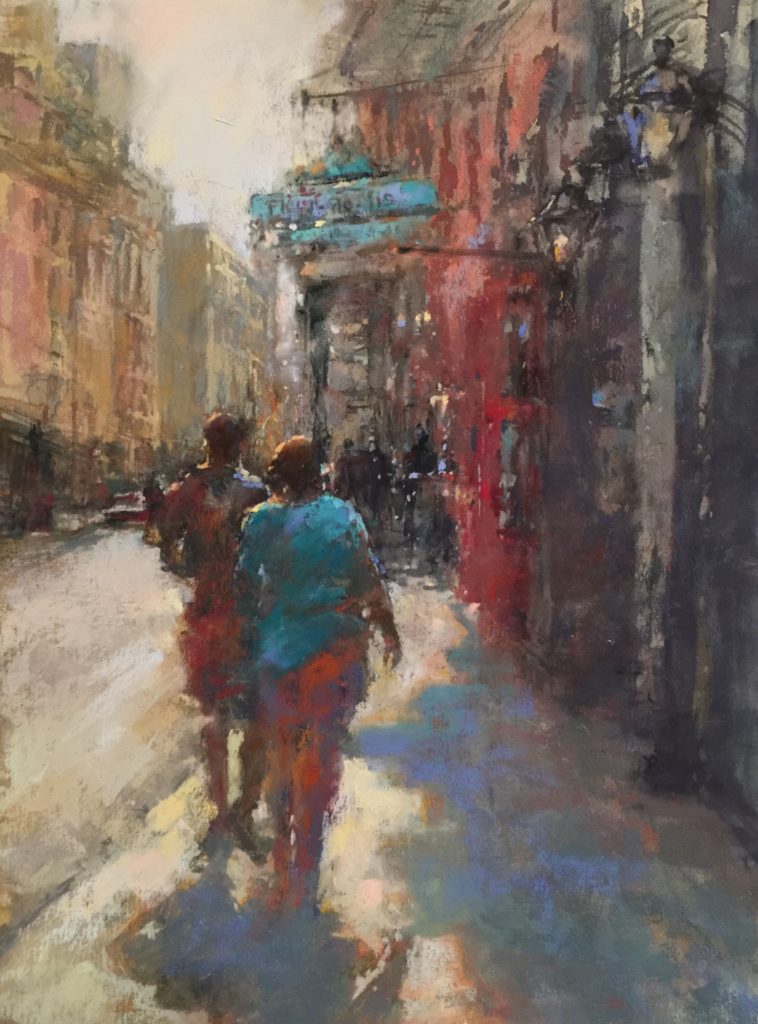
“I first created an underpainting in watercolor and loved the looseness of the way it came out. In fact, it worked so well that I didn’t need much pastel on top,” Nowak reveals. “There’s something about leaving just an impression of something that really intrigues me. In this case, I strove to create a quick impression of the lights and shadows and kept a loose, sketchy quality to the forms. I did play with the color harmonies some, like changing the color of the woman’s shirt to correspond with the sign above her head and simplifying things by limiting the palette to mostly blue and red, and also leaving a tonal quality to the buildings in the distance.”
Making Her Mark en Plein Air
Other characteristics in Nowak’s paintings are expressive mark making and the way she generally favors high value contrasts. ‘I don’t like to go out on gray days,” she says. “Strong contrasts help remind me not to paint objects, but instead to see and paint shapes of light and dark.” The way sunlight struck a neighborhood house became the impetus for “Nowak’s Right at the Corner.”
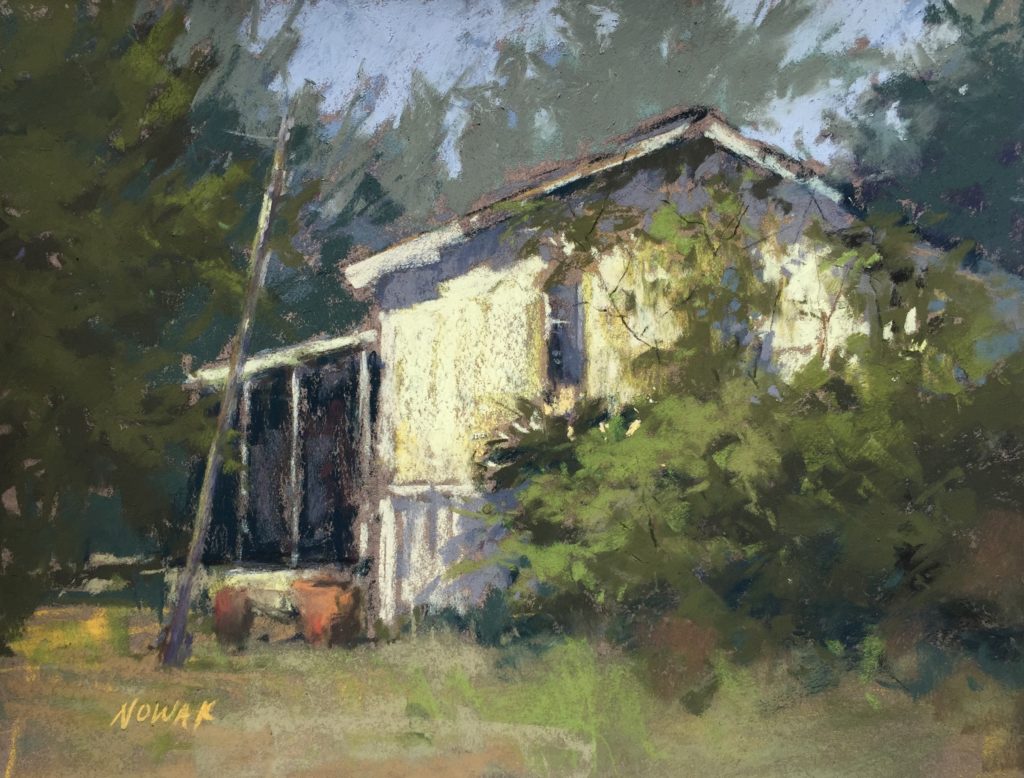
“Driving around one day, I saw the sunlight hitting the side of an ordinary house, making it look extraordinary,” she recalls. “I just loved that glow and set up my easel across the street. It was very hot that day, so I didn’t do an underpainting and worked really fast. I find when I’m working quickly, because I’m not thinking and laboring over it, my mark making is fresher, more energetic and confident. I’m just getting the image down in a few strokes and that’s it, as long as the values are right.”
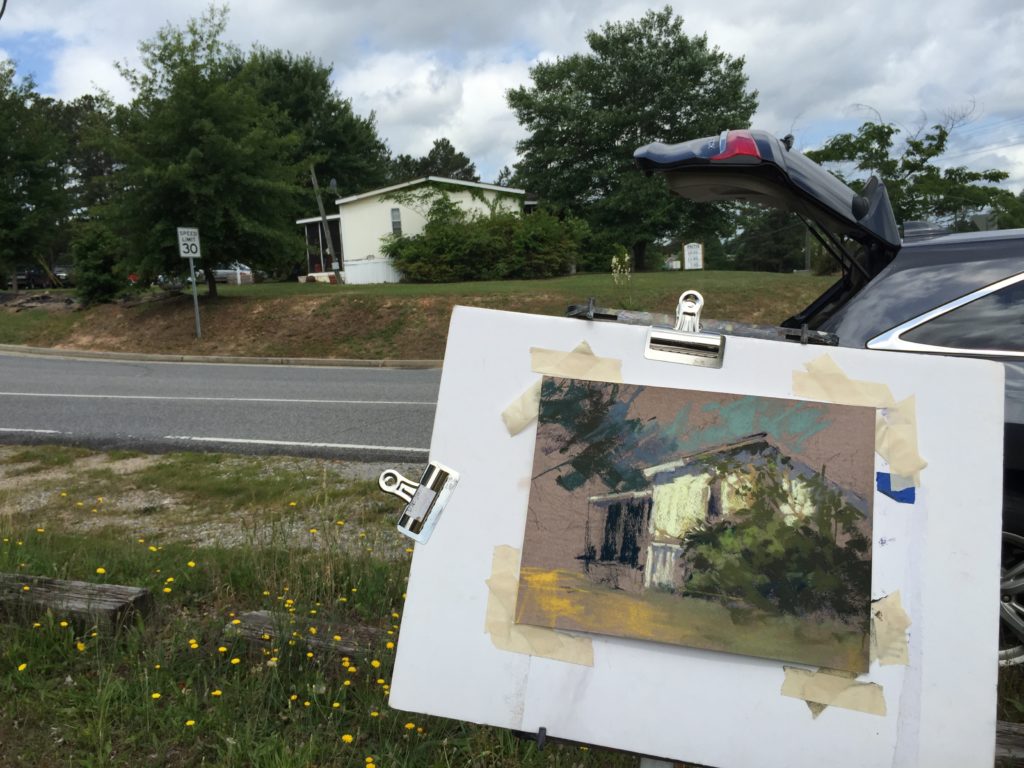
Undertaken at a plein air event, the alluring color harmonies, simplified value contrasts, and proficient mark making in “Gallery Street” surely attest to the strong emotional impact a well-handled impression of a subject can have. Most of Nowak’s painting time was concentrated on the focal area of the seated artist who was painting the scene from a different vantage point. The rest of the painting is quickly and boldly painted, much of it revealing her watercolor underpainting, most notably the greenery at left.
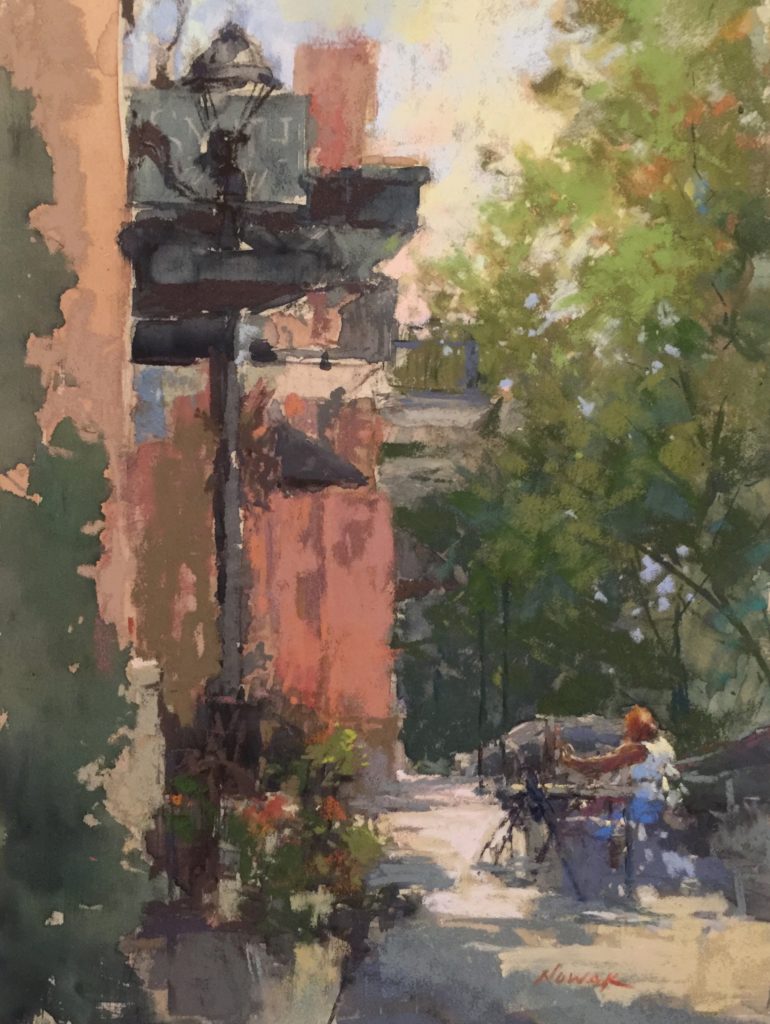
“Nothing kills a painting worse than overworking,” Nowak declares. “I have a stack of paintings that have died a slow death because I overworked them. I now stop painting when I feel a piece is about 80 percent finished. I put it aside and look at it after a couple of days with fresh eyes. At that point, I can better assess its merits and anything that might need improvement, then add a little more if needed.”
Finding One’s Voice en Plein Air
“My only true goal in painting is to be a better painter,” says Nowak. “I continue to challenge myself, experiment, and try new things in an effort to improve. After taking many classes and workshops, all of which helped me greatly in learning about many of the technical aspects of pastel painting, one of the most difficult things I faced was to find my own unique voice. What was it that I wanted to visually say that no one else was saying?” Thanks to lots of painting time and experimenting — trying different techniques, materials, and subjects — Nowak found the key. “I had to figure it all out so I could be my own artist, and I’m still working on that.”
She goes on, “Another thing is that I used to think that if I could duplicate exactly what I was seeing, I would be a really good painter. I quickly put that idea aside in order to learn how to really interpret a scene when creating a painting. I learned much more about lines, shapes, edges, color temperature, and the rest this way. Now, I’m always out to challenge myself. I don’t want to get in that safety trap of painting basically the same thing in the same way over and over again. I wouldn’t learn anything. I have to have intention — to find what it is about the scene that will challenge me and make me grow as an artist.”
She reflects, “Having a creative outlet is so important. With life’s stresses and issues, it’s great to just create for the sake of creating. To interpret a scene and produce something visually that no one else has is a very satisfying endeavor. Painting comes from within; it’s a personal expression. When others can relate and are moved by what I’ve painted, that’s just the icing on the cake!”
Visit EricRhoads.com to find out all the amazing opportunities for artists through Streamline Publishing, including:
– Online art conferences such as Plein Air Live
– New video workshops for artists
– Incredible art retreats
– Educational and fun art conventions, and much more.
> Subscribe to Plein Air Today, a free newsletter for artists
> Subscribe to PleinAir Magazine so you never miss an issue

